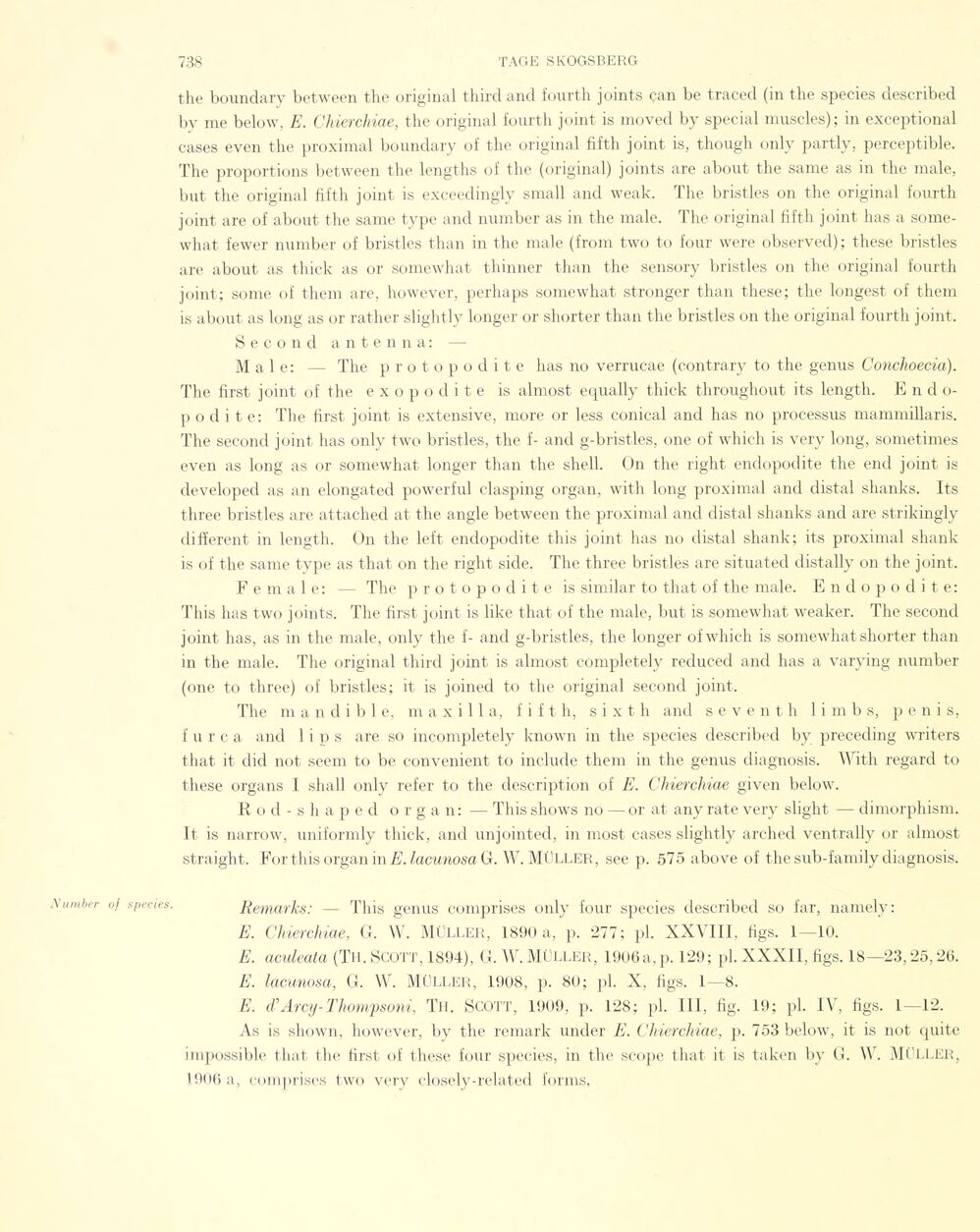
Full resolution (JPEG) - On this page / på denna sida - Sidor ...

<< prev. page << föreg. sida << >> nästa sida >> next page >>
Below is the raw OCR text
from the above scanned image.
Do you see an error? Proofread the page now!
Här nedan syns maskintolkade texten från faksimilbilden ovan.
Ser du något fel? Korrekturläs sidan nu!
This page has never been proofread. / Denna sida har aldrig korrekturlästs.
N u mb rr
the boundary between the original third and fourth joints çan be traced (in the species described
by me below, E. Chierchiae, the original fourth joint is moved by special muscles); in exceptional
cases even the proximal boundary of the original fifth joint is, though only partly, perceptible.
The proportions between the lengths of the (original) joints are about the same as in the male,
but the original fifth joint is exceedingly small and weak. The bristles on the original fourth
joint are of about the same type and number as in the male. The original fifth joint lias a
some-what fewer number of bristles than in the male (from two to four were observed); these bristles
are about as thick as or somewhat thinner than the sensory bristles on the original fourth
joint; sonie of them are, however, perhaps somewhat stronger than these; the longest of them
is about as long as or rather slightly longer or shorter than the bristles on the original fourth joint.
Second antenna: —
Male: — The protopodite has no verrucae (contrary to the genus Conchoecia).
The first joint of the exopodite is almost equally thick throughout its length.
Endo-p o d i t e: The first joint is extensive, more or less conical and has no processus mammillaris.
The second joint has only two bristles, the f- and g-bristles, one of which is very long, sometimes
even as long as or somewhat longer than the sheik On the right endopodite the end joint is
developed as an elongated powerful clasping organ, with long proximal and distal shanks. Its
three bristles are attached at the angle between the proximal and distal shanks and are strikingly
different in length. On the left endopodite this joint has no distal sliank; its proximal shank
is of the sanie type as that on the right side. The three bristles are situated distally on the joint.
F e m a 1 e: — The protopodite is similar to that of the male. Endopodite:
This lias two joints. The first joint is like that of the male, but is somewhat weaker. The second
joint has, as in the male, only the f- and g-bristles, the longer of which is somewhat shorter than
in the male. The original third joint is almost completely reduced and has a varying number
(one to three) of bristles; it is joined to the original second joint.
The m a n d i b 1 e, maxilla, fifth, s i x t h and s e v e n t h 1 i m b s, penis,
furca and 1 i p s are so incompletely known in the species described by preceding writers
that it did not seem to be convenient to include them in the genus diagnosis. With regard to
these organs I shall only refer to the description of E. Chierchiae given below.
R o d - s h a p e d organ: — This shows no — or at any rate very slight — dimorphism.
It is narrow, uniformly thick, and unjointed, in most cases slightly arched ventrally or almost
straight. For this organ in E. lacunosa G. W. Müller, see p. 575 abo ve of the sub-family diagnosis.
/ species. Remarks: — This genus comprises only four species described so far, namely:
E. Chierchiae, G. W. MÜLLER, 1890 a, p. 277; pi. XXVIII. figs. 1—10.
E. aculeata (Th. SCOTT, 1894), G. W. MÜLLER, 1906a,p. 129; pi. XXXII, figs. 18—23,25,26.
E. lacunosa, G. W. Müller, 1908, p. 80; pi. X, figs. 1—8.
E. (V Arcy-Thompsoni, T n. Scott, 1909, p. 128; pi. III, fig. 19; pi. IV, figs. 1—12.
As is shown, however, by the remark under E. Chierchiae, p. 753 below, it is not quite
impossible that the first of these four species, in the scope that it is taken by G. W. MÜLLER,
1906 a, comprises two very closely-related forms,
<< prev. page << föreg. sida << >> nästa sida >> next page >>